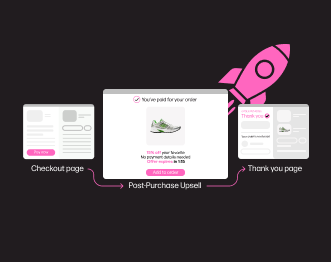Search in Ecommerce: Best Customer Examples
Improving your ecommerce site search is becoming increasingly important.
That’s why we’ve gathered some best-in-class examples from our client cases. They’ll demonstrate what you can achieve with your online store’s search functionality.
Table of contents:
- What is ecommerce site search?
- Why is ecommerce site search important?
- Customer examples:
- Product recommendations upon 0 search results
- Predictive autocomplete
- Merchandised search results
- Content within search results
- Dynamic facets and filters
- Error tolerance
- Product recommendations within the search bar
- Personalized search results
- Conclusion
What is ecommerce site search?
Ecommerce site search is the internal search engine on an online store that allows users to find products or information quickly and efficiently. Think of it as the digital equivalent of asking a helpful store associate where to find something.
When you visit an ecommerce website, whether you’re hunting for a specific product or just browsing, the search bar is your best friend. It’s that little box at the top of the page where you type in what you’re looking for—be it “red sneakers,” “wireless headphones,” or “organic dog food.” Hit enter, and voila! The site search sifts through the entire product catalog and serves the most relevant results in seconds.
An optimized site search does more than just match keywords. It corrects spelling mistakes, understands synonyms, and even suggests popular searches. Sophisticated algorithms and artificial intelligence power this. Shoppers need to be able to find exactly what they need with minimal effort.
Why is ecommerce site search important?
So, why is this so important? Because a good search experience can significantly boost sales and customer satisfaction.
When shoppers can easily find what they’re looking for, they’re more likely to make a purchase and return for more. On the flip side, a poor search experience can lead to frustration and lost sales.
In fact, research shows that:
- 69% of people immediately use the search bar, but 80% bounce due to a poor search experience
- 69% of consumers complain that they often see irrelevant search results
- 35% of consumers have left a site because of the search not showing relevant search results
- 81% of brands think the rising cost of living makes ecommerce search more important
Best ecommerce search examples:
Product recommendations upon 0 search results: Trotters
A 0 search result product recommendation is a clever feature in ecommerce that kicks in when a customer’s search query yields no results. Instead of leaving the shopper empty-handed and frustrated, the site suggests alternative products that might be of interest.
Imagine you type in “purple llama sweater” and get zero matches. Rather than hitting a dead end, the site might recommend other fun, colorful sweaters or popular items in the same category.
Research has shown that 56% of shoppers continue shopping on a website if it suggests other products when there’s a 0 results page. Providing product suggestions can help keep customers engaged and interested in making a purchase.
Therefore, websites need to have personalized recommendations to enhance the shopping experience for customers. However, only 34% of brands said they offer these!

The benefit? It keeps customers engaged and reduces the chances they’ll leave the site disappointed. By offering relevant alternatives, you not only improve the shopping experience but also increase the potential for sales, even when the exact item isn’t available. This nifty feature turns a potential negative into a positive, keeping shoppers happy and browsing longer.
Predictive autocomplete: Cox & Cox
Predictive autocomplete is a fundamental feature in ecommerce site search. The search algorithm starts suggesting possible search terms as soon as you begin typing. Picture this: you type “sneak” into the search bar, and before you even finish, options like “sneakers,” “sneaker cleaning kit,” and “sneaker storage” pop up.
In this example, you can see how homeware brand, Cox & Cox, proactively suggests products and complete search terms as a user begins typing their query. Upon typing ‘mi’, the system presents users with a number of search suggestions such as ‘mirror’, ‘mid-century’, and ‘mila side table’. It also shows a selection of Cox & Cox mirrors, predicting what users might be looking for.

The magic lies in how it speeds up the search process, guiding shoppers to popular or relevant items quickly and effortlessly. It saves time, reduces typing errors, and often leads to shoppers discovering products they didn’t even know they wanted.
Merchandised search results: G-shock
Merchandising search results is a savvy ecommerce strategy where retailers curate and prioritize the products shown in search results to impact the visibility and sales of certain items. It’s like having a store manager who knows exactly where to place products for the perfect customer experience.
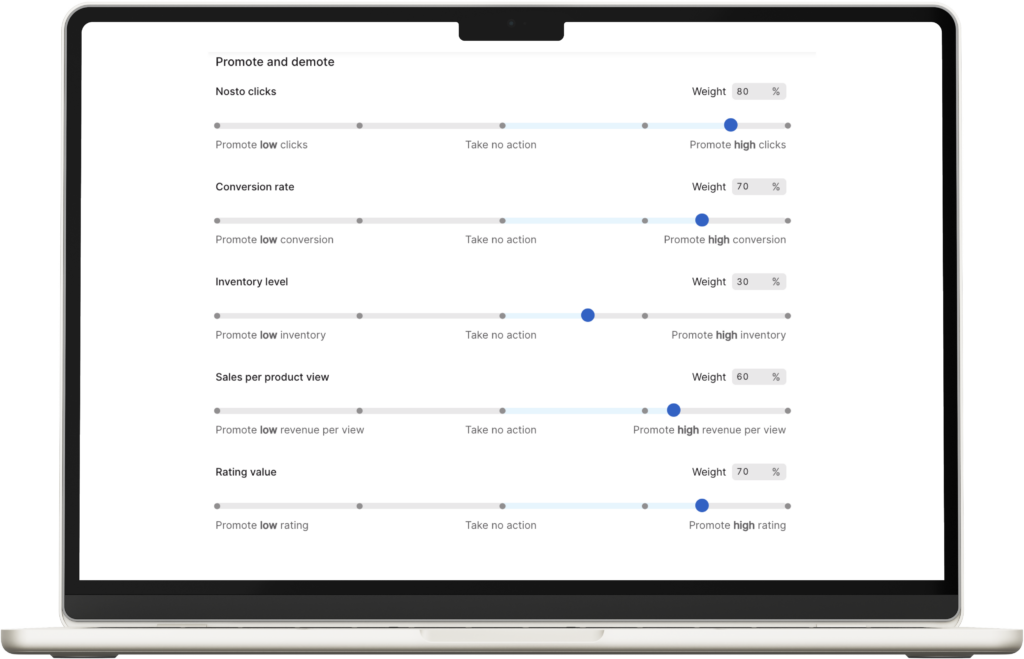
Take G-Shock, for example. They use a global merchandising rule in their search results that promotes products with high clicks, conversion rates, inventory levels, sales per product view, and customer ratings. This means that when you search for ‘digital watches,’ the top results are those with proven popularity, strong performance metrics, and high customer satisfaction.
Customers are more likely to discover and purchase top-performing products, leading to a more satisfying shopping experience. For G-Shock, it helps increase conversions, improve inventory management, and increase customer trust, all by strategically showcasing the best of what they offer.
If you want to know more about G-Shock and Casio’s ecommerce strategy, check out the full case study here.
Content within search results: Naturisimo
Using content within search results is another powerful tactic for enhancing the shopping experience. This means including relevant articles, blog posts, or guides alongside product listings within search results.
Take Naturismo, who offer the best in organic, natural, and vegan friendly cosmetics, skincare, makeup and wellness brands, for example.
If a shopper who viewed the ‘Beauty Box’ searches for ‘SPF’ on the Naturismo store, a banner highlighting the product they previously showed interest in will appear in the search results.
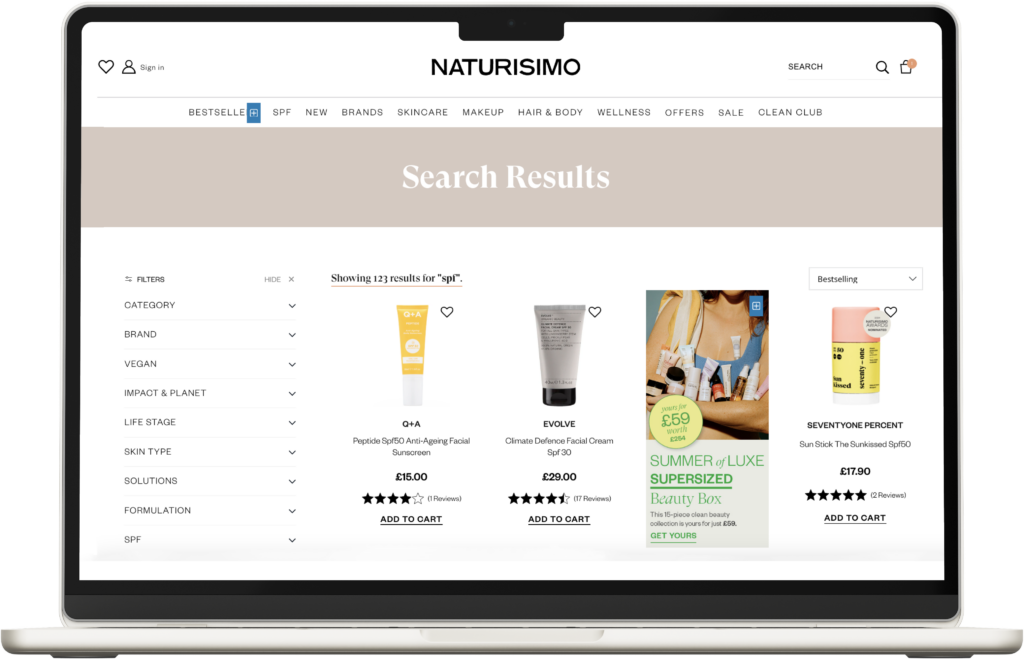
This approach educates shoppers, helping them make more informed decisions and boosting their confidence in their purchases. It also keeps customers engaged on the site longer, increasing the likelihood of additional purchases.
Dynamic facets and filters: Ylang 23
Facets and filters are used to help shoppers narrow down their search results. But dynamic facets and filters take it one step further, contextually adapting based on individual queries, and providing relevant options to help shoppers zero in on specific results with minimal effort.
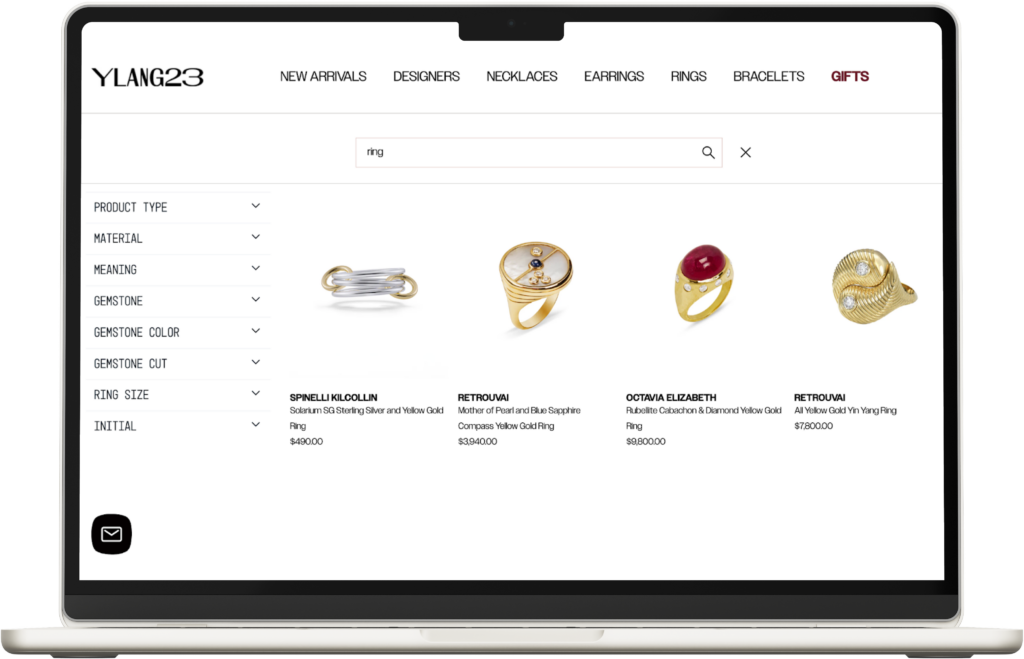
Premium jewelry brand, Ylang 23, has a vast product catalog and many items available in multiple variations. They wanted to ensure their facets and filtering allowed for a much more specific search experience.
Using Nosto’s data extractor tool, they created dynamic filters based on product tags, mirroring this in their search experience. When a user searches for ‘Necklace,’ ‘Chain length’ becomes an available facet to narrow results. Similarly, when a shopper searches for ‘Ring,’ ‘Ring size’ appears as a facet.
Error tolerance: Burt’s Bees Baby
Error tolerance is a crucial feature in ecommerce search, ensuring that even if shoppers make typos or misspellings, they can still find what they’re looking for. Burt’s Bees Baby, known for its organic and natural baby products, takes full advantage of this by implementing robust error tolerance in their search function.
Imagine a busy parent searching for ‘pyrjamas’ instead of ‘pajamas’ in the search box. Rather than showing zero results, Burt’s Bees Baby’s ecommerce search engine understands the user intent and still delivers the relevant product options.
Error tolerance smooths out the shopping experience, reducing frustration and helping customers quickly find the products they need, even when they’re in a rush or typing on the go.
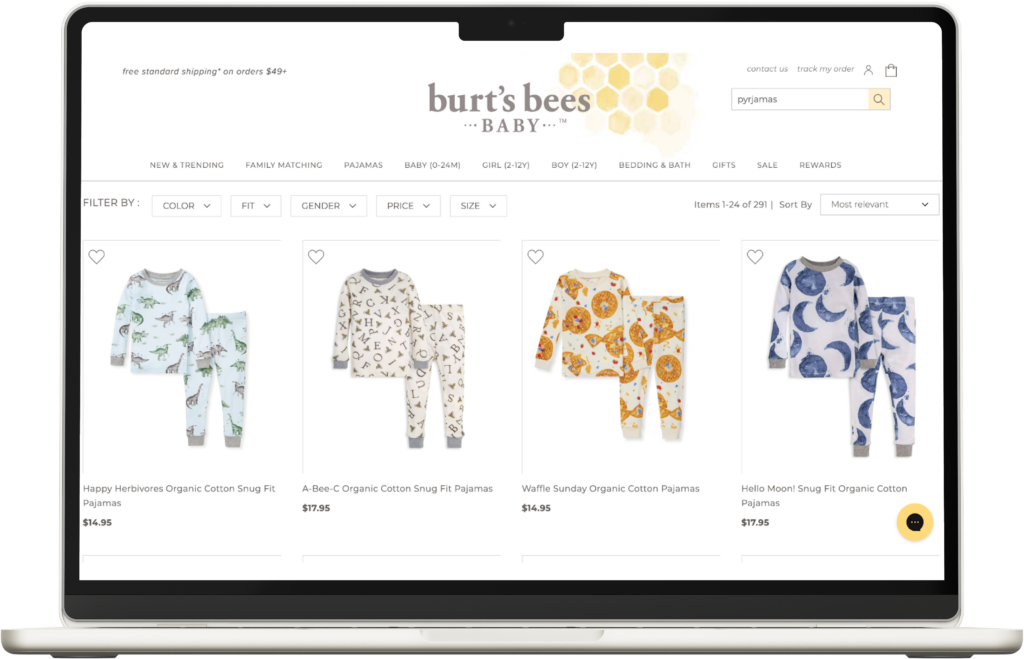
Product recommendation in search bar: Boody
Boody, the underwear brand made of sustainable bamboo viscose, takes a smart approach to engage high-intent shoppers by immediately showcasing a ‘popular products’ block even before they start typing.

By highlighting popular items upfront, Boody captures the attention of high-intent shoppers right away, reducing the time it takes for them to find and purchase products. This enhances the user experience and boosts conversion rates because customers are more likely to buy items that others have vetted and loved.
Personalized search results: Perry Ellis
Search personalization is another game-changer in ecommerce, tailoring the shopping experience to individual preferences and behaviors. Consumers now expect personalized search results, and personalized results based on their purchase history makes consumers 70% more likely to convert.
One way to make sure you show the right search results for each person is by organizing search results better through merchandising. This can help increase sales and make customers happier.
Our client, Perry Ellis, leveraged behavioral data to segment shoppers based on ‘style’ affinities, such as casual shirts versus dress shirts, and created dedicated merchandising rules for their search experience.
When you shop at Perry Ellis, the site remembers your preferences. If you often look for and purchase casual shirts, you will see the newest and most fitting casual styles in your search. Conversely, if dress shirts are your go-to, those will take center stage in your search results.
If you want to know more about Perry Ellis’ onsite search strategy, check out the full case study here.
Conclusion:
In today’s fast-paced digital world, a seamless and intuitive search experience is the backbone of successful ecommerce. Using predictive autocomplete, popular products, personalized search results, and error tolerance are important strategies to meet customer expectations and increase sales.
By optimizing your site search, you’re not just helping customers find products—you’re
enhancing their entire shopping journey. This leads to higher satisfaction, greater loyalty, and a stronger bottom line.
Speak to our ecommerce experts today to discover which strategies to implement and how.
Here are other great resources to help perfect your ecommerce search:


